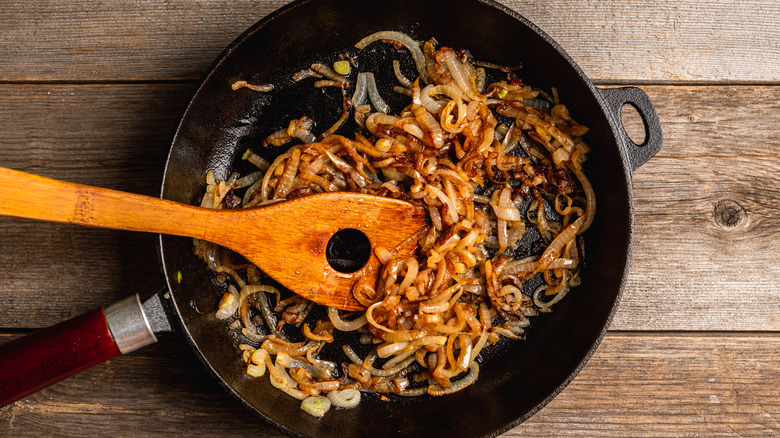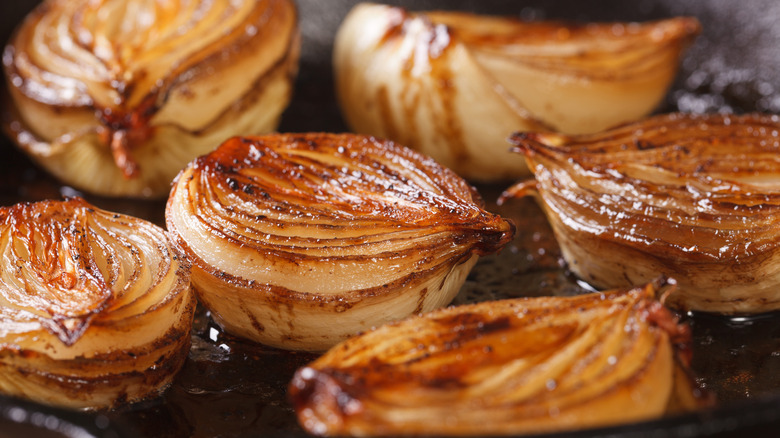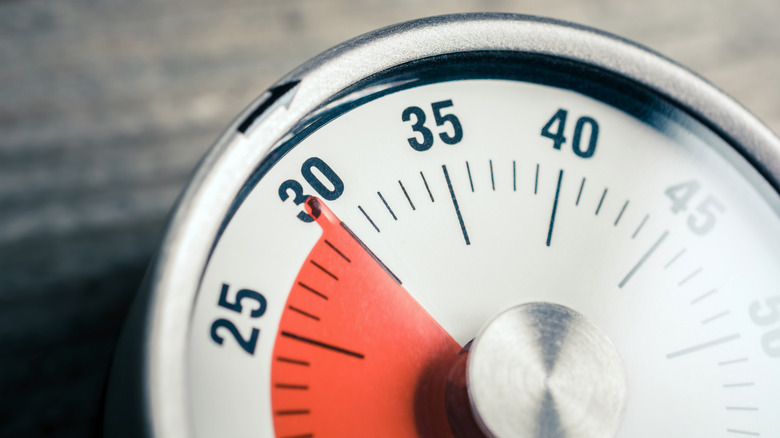The Key To Better Caramelized Onions Is Lots (And Lots) Of Time
When done right, the process of caramelizing onions transforms a batch of sharp and pungent alliums into a mass of smooth strands oozing rich umami and complex sweetness. This deep flavor also lends versatility, and even the most basic dishes can become a savory experience with the addition of caramelized onions. From being used as a topping to being blended into soups, dips, and pasta sauces, the list of uses transcends cooking styles and cuisines.
However, as is the case with making perfectly fluffy scrambled eggs, caramelizing onions is one of those cooking ventures that is simple, but not necessarily easy. And this is because one of the main ingredients to making the perfect batch of caramelized onions is time. Getting that deeply flavorful mahogany-colored mass of squishy onions is going to require at least 30 minutes of stirring, deglazing, and careful watching to ensure even cooking and no burning.
Sure, there are ways to speed up the process, or you can opt for the oven or pressure cooker to reduce the amount of elbow grease. But, as you'll see, these methods have caveats and you might have to sacrifice some flavor and texture along the way. That's not to say they shouldn't be used; in fact, it's good to have alternate methods to caramelize onions if you're short on time. However, there's a special relationship between caramelization and slow cooking that just cannot be ignored.
Understanding caramelization
Caramelization is the process of breaking down sugars to form aromatic and flavor compounds. One way to do this is by heating plain sugar, which is the case when making caramel sauce, candy, or even the crunchy bittersweet layer atop a crème brûlée. The natural sugars in fruits and vegetables can also be caramelized, giving rise to complex sweet, bitter, and nutty flavors.
An essential factor required for any good caramelization is low moisture, which helps concentrate natural sugars. While this can be achieved using high heat with vegetables like carrots that are sturdy enough to roast or sear, onions require a more delicate touch to concentrate and break down their natural sucrose into the sweeter simple sugars like glucose and fructose. And since high heat cannot be used, it needs to be substituted with a longer cooking time.
Caramelizing also requires uniform cooking, so start out with evenly cut onions using Gordon Ramsay's hack for keeping things tear-free. Since you're looking to get rid of excess water, use a wide pan that can accommodate the onions without crowding them too much. Of course, they eventually reduce in size, but the extra pan real estate helps cook off the liquid a little faster. While on the subject of cookware, using a cast iron or stainless steel pan will help develop a nice fond at the bottom, which can be deglazed and stirred back into the onions for a deeper flavor — something that a non-stick just won't do as well.
Time-saving tips that work, and ones that don't
First up, seasoning. Salting your onions early will help pull out moisture. Though this won't make a huge difference to cooking time, a bit of seasoning at the start helps spread its flavor evenly. Using sugar is trickier; adding a pinch to the onions will not shave off any minutes. Serious Eats found that caramelizing sugar in the pan and then adding in the raw onions reduced the cooking time by almost 5 minutes. Adding a pinch of baking soda can reduce cooking time even more significantly by speeding up the Maillard reaction. However, the onions will lose a lot of their texture and turn mushy in the process.
As far as cooking methods are concerned, roasting in the oven or using a pressure cooker are options. However, both will result in less control over the cooking process so there is a danger of the onions burning. Plus, caramelizing in the oven takes even longer than it does in a pan.
Arguably, the best approach to caramelizing onions quickly is by balancing the heat and fond formation in the pan by deglazing it with water as often as needed. As J. Kenji López-Alt points out in his quick caramelized onion recipe, cooking on high heat in a heavy-bottomed pan while keeping a sharp eye (and nose) out for burning can speed things up. Whenever the onions threaten to burn, deglaze the pan and stir the richly flavored fond back in. It's a high-risk maneuver, and you might end up with some burnt, bitter notes anyway. So, whenever you can, plan in advance to take the time to make caramelized onions the traditional languid way. You'll be glad you did.


